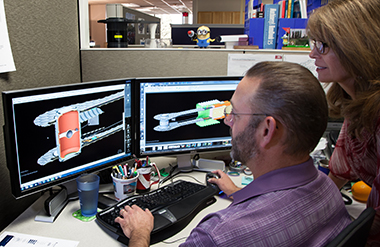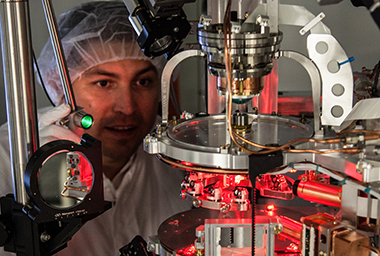Supporting stockpile stewardship through a wide range of nonignition experiments and pursuit of laser fusion ignition, and operating as a national user facility for high-energy-density science
In FY 2016, a total of 417 system shots were fired at the National Ignition Facility (NIF)—exceeding the year’s goal through continued improvements in efficiency. This number includes a recording-setting 17 shots during the last week of March. The total exceeded the figure for FY 2015 and more than doubled the 191 shots completed in FY 2014.
Experiments Supporting Mission Goals
NIF is serving as a highly productive cornerstone of stockpile stewardship. In FY 2016, 165 shots explored pertinent high-energy-density (HED) science and 146 advanced the prospect of demonstrating inertial confinement fusion (ICF) and energy gain, which is needed to develop an experimental platform for stockpile stewardship that provides thermonuclear burn. In addition, 33 system shots supported diverse national security applications, 38 focused on discovery science, and 35 were dedicated to developing new experimental capabilities.
Stockpile Stewardship HED Science Experiments
HED science experiments at NIF explored wide-ranging physical phenomena central to stockpile stewardship. The shots gathered information about the properties of high- Z (high-atomic-number) materials at extreme conditions, radiation hydrodynamics and transport, and material mixing. These issues are critical to understanding nuclear weapons performance and improving the predictability and results of fusion ignition experiments. Researchers conducted the first material dynamics experiments examining the strength of plutonium at extreme conditions, and they continued a series of high- Z diffraction shots to study plutonium’s equation-of-state at extreme pressures. Shots with tantalum foils tested both high- Z material strength models and new experimental platforms that provide greater capabilities. Tantalum becomes even stronger at the pressure of 3.5 and 5.0 million atmospheres (megabars)—at least two times stronger than strength model predictions.
Progress in Studying Fusion Ignition
Achieving fusion ignition and energy gain at NIF is a grand scientific challenge, and scientists are making progress on several fronts. Adjustments to the laser pulses (called “adiabat shaping”) are reducing hydrodynamic instabilities, and changes to the hohlraum (the case enclosing the fuel capsule) are helping control the overall symmetry of implosions. In addition, the R&D 100 Award–winning polyelectrolyte enabled liftoff (PEEL) technology offers an approach to reduce the implosion asymmetries caused by the “tent”— an ultrathin membrane that supports the target capsule within the hohlraum. ICF and many facets of HED research will further benefit from the newly commissioned Advanced Radiographic Capability (ARC). In FY 2016, the diagnostic was used for radiography experiments. ARC undergoes continuing testing to create a radiographic “movie” of the critical phases of an ICF implosion.
A new “wetted-foam” target design, first tested at NIF in FY 2016, will open up opportunities to study the target’s central hot spot and its surrounding region. Developed by a team of researchers from LLNL, Los Alamos, and General Atomics, these target capsules are lined with a polymer foam that is saturated with liquid deuterium–tritium fuel. ICF shots in FY 2016 also included “shock/shear” experiments, led by scientists from Los Alamos. The tests were designed to further understand turbulent mix models. The target used in the experiment—a miniaturized shock-tube that includes a thin metal foil—is sheared by shock waves passing in opposite directions on opposing sides of the foil.
Discovery Science at NIF
In early August, the NIF team devoted a full week of experimental time to Discovery Science, providing five user groups with access to the unique HED conditions that NIF can create. One team continued a campaign to create collisionless shocks, which occur at astrophysical scale in supernova remnants, gamma-ray bursts, and cosmic ray acceleration. Another team studied Rayleigh–Taylor instability growth, and two others investigated the properties of warm dense plasmas that are created in ICF experiments and may be found in the core of large planets. In addition, the first three Turbulent Dynamo campaign experiments took place. The goal of these experiments, led by a team from Oxford University, is to study how the kinds of turbulent plasma conditions that exist throughout the cosmos amplify small “seed” magnetic fields into the fields that fill galaxies such as the Milky Way.
Another new series of Discovery Science experiments is exploring nucleosynthesis, the process by which stars make heavier elements from hydrogen and helium. Researchers can create conditions in a NIF experiment that are very similar in density and temperature to the interior of a star. The first three experiments focused on the chain of nuclear reactions that convert hydrogen into helium and turn a small amount of matter into energy. The multi-institutional team of researchers is measuring the reaction rates—data to be used to inform and improve models of nuclei production in stellar interiors. Two more rounds of experiments are scheduled.
Technologies to Improve Operations and Capabilities
In addition to many procedures that have increased operational efficiency, new technologies and equipment are also improving NIF’s shot rate. In FY 2016, the NIF team installed the first of two new Target and Diagnostic Manipulators (TANDMs). They also installed the Advanced Tracking Laser Alignment System (ATLAS) and a new Target Alignment Sensor (TAS) that work together to provide NIF a wholly integrated alignment system. ATLAS speeds up the exacting process of aligning diagnostics inside the target chamber. This tracking system is more flexible and offers greater capability than the two systems previously used to align the diagnostic instrument manipulators (DIMs). ATLAS also eliminates the need to install additional target alignment systems as new capabilities such as TANDMs are commissioned. Each TANDM is a combination DIM and positioner for warm targets. Operations with the newly deployed TANDM together with the current target positioner (TarPos) are more efficient. They allow NIF’s third target positioner (Cryo TarPos) to be dedicated to growing cryogenically cooled target layers while the others service experiments.









